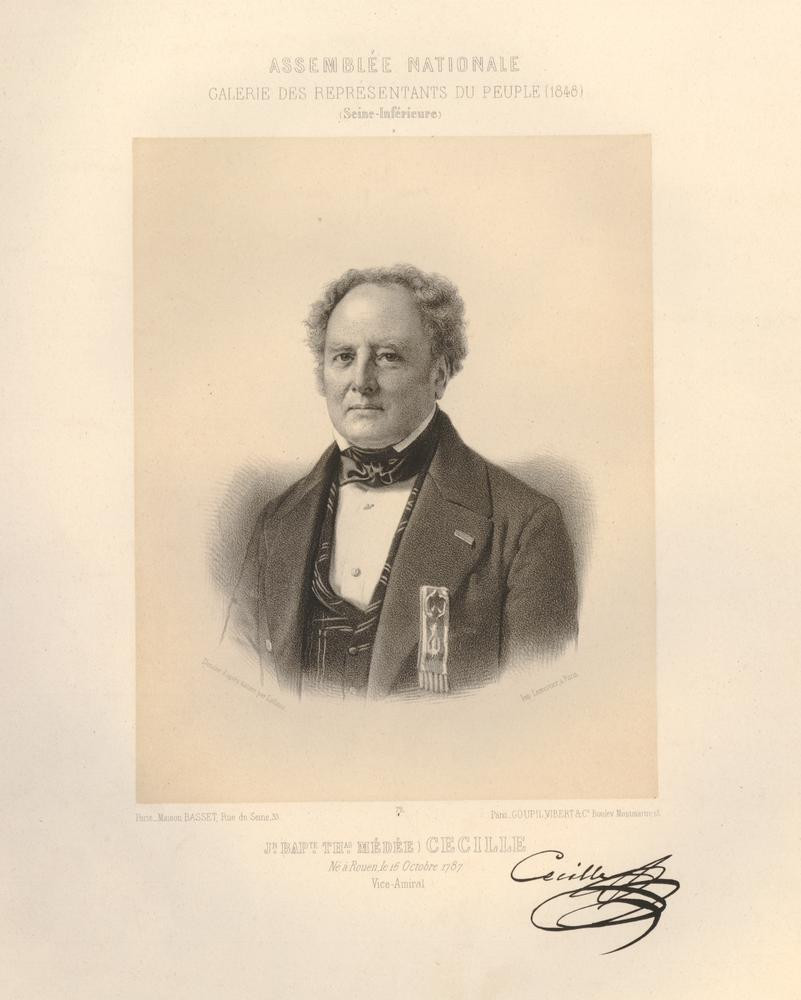
CÉCILLE admiral (EN)
Biographical Article
Jean-Baptiste Thomas Médée Cécille was a French Admiral, born on October 16, 1787 in Rouen (Seine-Maritime) and deceased on November 9, 1873 in Saint-Servan (Saint-Malo, Ille-et-Vilaine). He is buried in the monumental cemetery of Rouen.
Jean-Baptiste Cécille was a Navy officer who obtained the rank of Vice-Admiral in 1847. As head of the French fleet in the China Sea, he was notably responsible for preparing the Lagrené mission (1843-1846), along with Adolphe-Philibert Dubois de Jancigny (1795-1860) whom he accompanied to China and Southeast Asia during the negotiations for the Treaty of Whampoa (October 24, 1844). In 1846, he was the first Frenchman to land in the Ryūkyū Islands and tried unsuccessfully to land in Nagasaki Bay. He was appointed grand officier of the Légion d’honneur on May 3, 1849 (AN, LH//460/19) and then returned to politics. He served two terms as deputy under the Second Republic, between 1848 and 1852 (Robert A., 1889-1891). As a supporter of Louis-Napoleon Bonaparte, he became a senator in 1852.

CC BY-NC-SA 4.0
The Collection
During his travels in the Pacific in 1839 and 1844, Admiral Cécille made various shipments to French museums. In 1839, the Muséum d’histoire naturelle in Rouen notably received the superb bow of a sculpted canoe taken from a chief of the Chatham Islands (New Zealand) after a violent incident between natives and French whalers, then in 1844 several other objects (Boulay R., 2012, p. 25-27). On September 9, 1844, boxes sent by Cécille de Macao arrived in Le Havre. They contained objects intended for the king, the musée de Sèvres and the naval museum (three cases containing models of boats have to date not been located) as well as books for the Bibliothèque Royale (AN, Z8, September 9, 1944). The Musée national de la marine also preserves two falcons mounted on pivots, 116 cm long - sent by Admiral Cécille and received on December 27, 1845 - weapons of war taken from the home of a pirate leader in Maluzo (Basilian Island, Soulou archipelago, Malaysia), following the expedition of the corvette La Victorieuse to avenge the death of a French officer and sailor.
Upon his death, he bequeathed several works to the Musée des Beaux-Arts in Rouen that entered the museum in 1875: a charcoal landscape by Mme Lalanne, and six paintings: Glaneuse and Rigolette by Joseph-Désiré Court (1797-1865) ; Soleil couchant (île de Wight) and Après l’orage (près d’Hastings) by Friedrich Fritz Hildebrandt (1819-1885); Attaque de pirates malais (missing since 1964) and La Frégate L’Érigone by Auguste Mayer (1805-1890); these latter two paintings, linked to the career of Admiral Cécille, were undoubtedly commissions.
The collection, which was accumulated during his stay in China at the time of the Lagrené mission, with many objects close to those brought back by the commercial delegates of this mission, remained in his family and was bequeathed to the Musée des Beaux-Arts in Brest by his son-in-law François-Auguste Danguillecourt (1819-1913) who spent most of his career as a naval commissioner in Paris. The collection was inventoried in Brest in 1914 (s.c., legs Danguillecourt, collection du vice-amiral Cécille, 1914) and contained more than five hundred objects. Evacuated during the Second World War, the collection escaped the museum’s destruction and was only revived during the “Brest-Asia” exhibition in 2004 (Brest-Asie. Regards sur une collection, 2004). The collection also contained Japanese objects and books, mostly acquired in Europe, either by Cécille or his son-in-law, in particular numerous volumes of Hokusai's Manga 葛飾 北斎 (1760-1849) and illustrated books by Kyosai 河鍋 暁斎 (1831-1889).
The collection that was assembled in China at the time of the Lagrené mission contains a snuffbox with four drawers in black lacquer decorated in mother-of-pearl with landscapes including Japanese houses on the outside, and flowers on the inside (L 'Or du Japon, 2010, n° 10, repr.; À l’aube du japonisme, 2017, n° 22, repr.; Lacambre G., 2018, p. 85, fig. 23, repr.), According to a handwritten note, the snuffbox was to him in Canton by San-tsé-tchen, a collaborator of Qi-ying (1790-1858), the Chinese negotiator of the Treaty of Whampoa in 1844. By comparison with a snuff box in the same style brought back by the Lagrené mission, classified as Japanese lacquerware upon entering the Musée de la Marine at the Louvre in 1849 and now conserved at the musée du quai Branly-Jacques Chirac (À l’aube du japonisme, 2017, n ° 21, 22, repr.), Cécille’s snuffbox is one of the Japanese items that was available in the Canton market. The same is true of a pipe and its case (Brest-Asie, 2004, p. 4, repr.), a bowl with a lid in red lacquer on the inside and dark green with gilt decoration on the outside. A similar Japanese bowl, deposited in La Rochelle, could be identified by comparison as coming from the Lagrené mission (À l’aube du japonisme, n° 19, 20, repr.).

Related articles
Collection / collection d'une personne

Personne / personne

